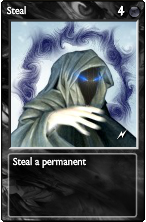War Metagame Spotlight: Darkness Domination
With War 5's changes to off-element card maximums in initial Vaults, most teams have found themselves in need of ways to incorporate permanent control into their decks in order to fend off the Aether-based Ramp decks featuring Dimensional Shield and Fractal that were highly successful during War 4. Since Butterfly Effect is too clunky to use, and Pulverizer requires dipping into ![]() quanta (therefore making it only viable for Team Entropy, Team Earth, and Team Gravity), Deflagration and Steal are therefore the go-to cards for dealing with powerful permanents.
quanta (therefore making it only viable for Team Entropy, Team Earth, and Team Gravity), Deflagration and Steal are therefore the go-to cards for dealing with powerful permanents.
Contents
Steal vs. Deflagration
Although Fire duos with Deflagration are also a possibility for War teams, it was not as common for the following reasons:
- Fewer suitable supporting cards (only Deflagration and Rage Potion were good choices for splashing into decks, as the remaining Fire cards either cost too many quanta to play, or required upgrade slots to be used, in the case of Minor Phoenix)
- The supporting cards offered by Darkness were comparatively better (as an element, Darkness is one of the most balanced, with its variety of rush, control, and stall deck options that can be made with only in-element cards)
- Since the main targets for permanent control were powerful shields such as Dimensional Shield and Wings, it was usually a more advantageous to steal them instead of simply destroying them
Although a Fire duo can offer creature control, permanent control, and a resilient low-cost creature, Darkness duos offer more utility in its card choices.
Card Breakdown
Darkness Cards
Steal: Counters powerful enemy permanents. Especially useful against shields that can otherwise stop the in-element creature base from winning damage races.
Nightmare: Provides hand disruption, draw disruption, burst healing, and spell damage. Very effective for reducing the burst damage potential of Fractal-based decks.
Vampire Dagger: One of the most powerful weapons. Creates a 12 HP differential in the player's favour each turn by decreasing the opponent's HP by 6, and increasing the player's own HP by 6.
Other Darkness Options
Drain Life: While it does take a lot of quanta to use as an effective means of creature control, Drain Life allows elements without creature control of its own to fend off early attackers from the opposition.
Liquid Shadow: An interesting option to consider when paired with higher HP creatures for even more mid-game healing and counter-rushing.
Dusk Mantle: Not the most ideal choice, since Steal will usually be netting the user a useful shield, and its high casting cost of 6 ![]() strains the Darkness quanta base a little too much.
strains the Darkness quanta base a little too much.
In-Element Cards
Although each element will have different ways of building a Darkness Domination deck, the following types of cards are common components:
Resilient Creatures: The ideal group of creatures to use are mid-range creatures or Dragons that have a good damage to cost ratio, along with a relatively high HP count (for surviving damage-based creature control). Noteworthy examples are Abyss Crawler, Arctic Dragon, Ghost of the Past, Golden Nymph, Sky Dragon, Gargoyle, Elite Charger, and Phoenix.
Creature Control: To allow enough time for the deck's efficient mid-range creatures to be cast, it's essential to have some answers to opposing creature rushes. Whether it's damage-based creature control (Lightning, Shockwave, Rage Potion) or soft creature control (Antimatter, Basilisk Blood, Reverse Time), being able to repel the opponent's creature army and gain a tempo advantage is crucial.
Play Style
Darkness Domination aims to play an early Vampire Dagger for its excellent damage differential, and delaying or removing opposing creature threats with creature control while gathering quanta to play its own creatures. Nightmare is used for some mid-game disruption (draw denial and some extra healing) after the deck has played its first creature, while Steal is used to remove the opponent's defences in the late game to ensure that the mid-range creature army does enough damage to secure a win. Alternatively, an early Steal capitalizes on a poor quanta draw by the opponent and presses the advantage gained.
Sample Decks
Darkness Domination decks were used successfully by many teams throughout the course of War 5.
Team Time
Although Team Time played many different variations of Darkness Domination, the following were the most common:

5rg 5rg 5rg 5rg 5rg 5rg 5t2 5t2 5t2 5rk 5rk 5rk 5rk 5rk 5ru 5ru 5ru 5ru 5ru 5s4 5up 5up 5up 5v1 5v1 7q0 7ri 7q5 7tb 7tb 8pt

5rg 5rg 5rg 5rg 5rg 5rg 5rk 5rk 5rk 5ru 5ru 5ru 5ru 5ru 5s4 5t2 5t2 5t2 5t2 5t2 5up 5up 5up 5up 5v1 5v1 5v1 7q0 7tb 7tb 8pt
Perhaps the quintessential examples of Darkness Domination, Team Time's creations are much more than just modified Ghostmares. The addition of Steals allow it to deal with permanents much more effectively than a regular (6 Nightmare + 6 Ghost of the Past) version can, and ensure that shields will not stop its creature army from doing damage. Having fewer Nightmares in the deck is not a problem, as the Steals and Vampire Daggers bring enough utility to the deck in a War metagame. Reverse Time does double duty by holding off early creature assaults and also preventing the opponent from drawing a new card for one turn. Golden Nymph is a resilient creature threat that nets card advantage -- even if it dies the turn immediately after being played, it usually cost the opponent two cards to remove it from play -- and a tactical advantage with its Precognition ability. Golden Hourglass is another possible addition to help sift through the deck when there are enough upgrade slots to use upgraded quanta sources, as most of the other cards in the deck don't benefit as much from upgrading, and a faster quanta start allows for earlier control of the board.
Team Air
Team Air's variant took a more balanced approach, with a mix of aggressive, defensive, and controlling elements.
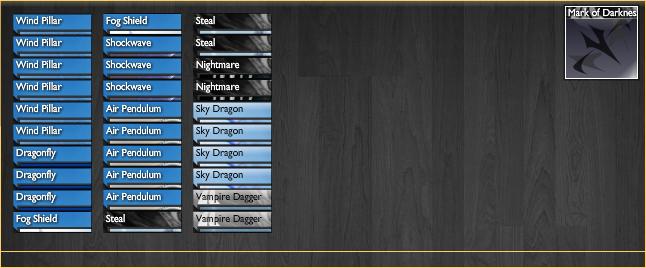
5oc 5oc 5oc 5oc 5oc 5oc 5od 5od 5od 5og 5og 5on 5on 5on 5pu 5pu 5pu 5pu 5pu 5up 5up 5up 5v1 5v1 7mv 7mv 7mv 7mv 7tb 7tb 8pt
Dragonfly provides quanta acceleration to play Sky Dragon, which is a powerful threat that is highly resistant to creature control. Fog Shield and Shockwave provide early anti-rush support before the main source of damage comes into play.
Team Water
Team Water's take on the Darkness Domination deck focused on slowing its opponents to a crawl before steadily winning with its own creature army.

5i4 5i4 5i4 5i4 5i4 5i4 5i4 5i4 5i4 5i8 5i8 5i8 5jm 5jm 5jm 5jm 5up 5up 5v1 5v1 5v1 5v1 7gm 7gm 7gm 7gm 7gm 7gm 7tb 7tb 8pt

5i4 5i4 5i4 5i4 5i4 5i4 5i4 5i4 5i4 5ib 5ib 5ib 5ie 5ie 5ie 5ie 5jm 5jm 5jm 5jm 5up 5up 5v1 5v1 5v1 5v1 7gm 7gm 7tb 7tb 8pt

5i4 5i4 5i4 5i4 5i4 5i4 5i4 5i4 5i4 5i8 5i8 5i8 5i8 5jm 5jm 5jm 5up 5up 5up 5v1 5v1 5v1 7gm 7gm 7gm 7gm 7gm 7gp 7tb 7tb 8pt
Depending on the number of upgrades available, Abyss Crawler or Toadfish can be used as the win condition. Although Abyss Crawlers are tougher and cost fewer quanta to cast, Toadfish don't need to use an upgrade slot. As for creature control, there are multiple options, from Ice Bolt when playing against a deck with few creatures (also useful as an additional damage source), Arctic Squid for playing against decks with little or no creature control, or Permafrost Shield when playing against swarms of small creatures.
Team Death
Team Death's variants were more aggressive, and traded away its control aspects for speed and greater damage potential.

52g 52g 52g 52g 52g 52g 52g 52h 52h 52h 52h 52t 52t 52t 52t 52t 542 542 542 542 542 542 542 5uo 5up 5up 5up 5v1 5v1 7ta 7tb 8pt

52g 52g 52g 52g 52g 52t 52t 52t 52t 542 542 542 542 542 542 542 542 5up 5up 5v1 713 718 718 718 718 718 7t8 7t9 7t9 7tb 7tb 8pt
Deadly Poison provides an alternate damage source, while aggro-oriented creatures such as Flesh Recluse, Mummy, and Bone Dragon have synergy with the creature-buffing effect of Eclipse.
Team Earth
Team Earth took advantage of its high-quality in-element creatures to create variants of Darkness Domination that were suited towards an aggressive mid-game.

4vj 4vj 4vj 4vj 4vj 58o 58o 58o 58o 58o 590 590 590 590 590 595 595 595 5aa 5aa 5aa 5up 5up 5ur 5ur 5v1 5v1 5v1 77a 77a 8pt

58o 58o 58o 58q 58q 58s 58s 591 591 5aa 5aa 5aa 5aa 5aa 5aa 5aa 5aa 5aa 5aa 5aa 5aa 5up 5up 5uv 5uv 5uv 5v1 5v1 7tb 7tb 8pt
Graboid, Steel Golem, and Gargoyle are great early-mid game threats that are hard for the opponent to ignore. Basilisk Blood and Titanium Shield help deter large creatures and creature swarms, respectively. The Nova-Graboid core of the first deck allows for fast and aggressive starts.
Team Entropy
Team Entropy's variants were more disruptive, with support cards focused on denial.
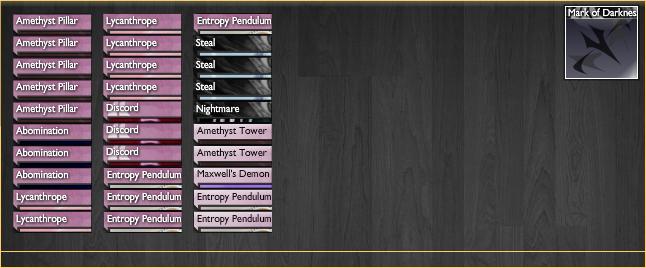
4vc 4vc 4vc 4vc 4vc 4ve 4ve 4ve 4vh 4vh 4vh 4vh 4vh 4vh 4vl 4vl 4vl 50u 50u 50u 50u 5up 5up 5up 5v1 6ts 6ts 6tt 6ve 6ve 8pt

4vc 4vc 4vc 4vc 4vc 4vc 4vg 4vh 4vh 4vh 4vh 4vh 4vl 4vl 4vn 4vn 50u 50u 5up 5up 5up 5v1 6ts 6ts 6tv 6tv 6tv 6tv 6tv 6ve 6ve 8pt
Here, Vampire Dagger is replaced with Discord, as the tempo advantage gained by playing one early on and locking down the opponent's quanta for even one or two turns is tremendous. Maxwell's Demon and Antimatter provide some creature control mid-game, when Lycanthrope, Abomination, and Amethyst Dragon start taking the lead in the damage race.
Team Darkness
As the element with access to full complements of Steal, Vampire Dagger, and Nightmare, Team Darkness created some strange and unexpected uses of the Darkness Domination archetype.
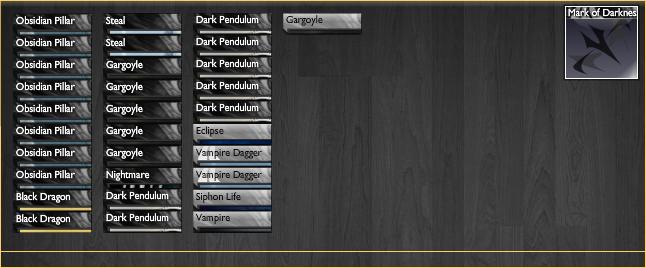
5uk 5uk 5uk 5uk 5uk 5uk 5uk 5uk 5ul 5ul 5up 5up 5uv 5uv 5uv 5uv 5uv 5v1 606 606 606 606 606 606 606 7ta 7tb 7tb 7tc 7td 7tf 8pt
Mono-Darkness with a mid-range twist. Instead of taking a more control-based approach with Devourer and Vampire, the use of Gargoyle adds more mid-game power at the cost of early-game presence.

593 593 593 593 593 5uk 5uk 5uk 5uk 5ul 5ul 5ul 5ul 5um 5um 5um 5um 5um 5um 5up 5up 606 606 606 606 606 606 606 606 7tb 7tb 8pm
A more denial-based version of the Darkness Domination, with extra quanta control from Devourer and Earthquake to punish decks for skimping on quanta sources.

5uk 5uk 5uk 5uk 5uk 5uk 5uk 5uk 5uk 5ul 5ul 5up 5up 5us 5us 5us 606 606 606 606 61q 61q 61q 61q 61q 61q 622 622 7t8 7tb 8pu
Splashing Lightning helps the deck answer early creature threats and prepare for a late-game assault of Fractalled Black Dragons.
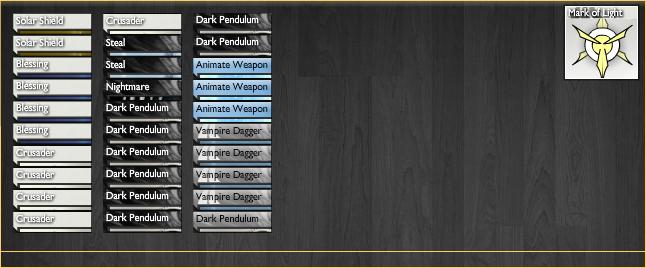
5ld 5ld 5lf 5lf 5lf 5lf 5ll 5ll 5ll 5ll 5ll 5up 5up 5v1 606 606 606 606 606 606 606 606 7n2 7n2 7n2 7tb 7tb 7tb 7tb 7um 8pq
There's little early defence to speak of, but the damage and healing potential is huge once the combo pieces start coming together.

5oi 5oi 5oi 5oi 5up 5v1 5v1 5v2 5v2 606 606 606 606 606 606 606 606 606 606 606 606 606 7n5 7n5 7n5 7n7 7t8 7t9 7tb 7tb 8pr
Eagle's Eye is an excellent source of reusable creature control, especially when flown. Using Nightmare on your own flown weapons is hilarious.

4vj 4vj 4vj 5oi 5rk 5rk 5rk 5rk 5ru 5s4 5uk 5uk 5uk 5ul 5ul 5ul 5up 5v1 606 606 606 606 606 606 606 606 6rs 7q5 7tb 7tb 80a 8ps
Ghostmare is still incredibly powerful with just 1 each of Ghost of the Past and Nightmare, due to the use of a Darkness Domination backbone.
Conclusion
Darkness Domination is an incredibly versatile archetype that is well-suited to countering permanent-reliant decks. As one of Team Time's main deck archetypes, Darkness Domination proves to be a strong contender in the War metagame.


